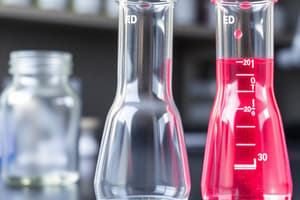Podcast
Questions and Answers
What do standard electrode potentials, represented as E⁰ values, measure?
What do standard electrode potentials, represented as E⁰ values, measure?
- The individual potential of a reversible electrode at standard conditions (correct)
- The color of the electrode
- The volume of the electrode
- The weight of the electrode
Why are standard electrode potentials important in electrochemistry?
Why are standard electrode potentials important in electrochemistry?
- To determine the color of the electrode
- To understand the electrochemical behavior of elements (correct)
- To measure temperature changes
- To calculate volume changes in the electrode
What conditions are standardized for measuring electrode potentials?
What conditions are standardized for measuring electrode potentials?
- Temperature, pressure, concentration (correct)
- Temperature, weight, concentration
- Temperature, color, volume
- Temperature, pressure, weight
What serves as a universal reference for measuring electrode potentials?
What serves as a universal reference for measuring electrode potentials?
Under standard conditions, what potential is assigned to the Standard Hydrogen Electrode (SHE)?
Under standard conditions, what potential is assigned to the Standard Hydrogen Electrode (SHE)?
Why is it important to determine electrode potentials under standardized conditions?
Why is it important to determine electrode potentials under standardized conditions?
What does E⁰ represent in standard electrode potentials?
What does E⁰ represent in standard electrode potentials?
What is the role of a reversible electrode in standard electrode potentials?
What is the role of a reversible electrode in standard electrode potentials?
Which component is bubbled over the platinum electrode in the Standard Hydrogen Electrode (SHE)?
Which component is bubbled over the platinum electrode in the Standard Hydrogen Electrode (SHE)?
What does SHE stand for?
What does SHE stand for?
What is the role of the Standard Hydrogen Electrode (SHE) in electrochemistry?
What is the role of the Standard Hydrogen Electrode (SHE) in electrochemistry?
How are standard electrode potentials expressed by convention?
How are standard electrode potentials expressed by convention?
What does a positive standard electrode potential (E⁰) value indicate?
What does a positive standard electrode potential (E⁰) value indicate?
How do positive E⁰ values correspond to agents in redox reactions?
How do positive E⁰ values correspond to agents in redox reactions?
What do metals with highly negative E⁰ values tend to be?
What do metals with highly negative E⁰ values tend to be?
How are nonmetals with highly positive E⁰ values described?
How are nonmetals with highly positive E⁰ values described?
What do positive cell potentials indicate in redox reactions?
What do positive cell potentials indicate in redox reactions?
Why are standard electrode potentials crucial in applications like corrosion prevention?
Why are standard electrode potentials crucial in applications like corrosion prevention?
What is the significance of conducting experiments involving standard electrode potentials?
What is the significance of conducting experiments involving standard electrode potentials?
How do E⁰ values contribute to designing electrochemical cells?
How do E⁰ values contribute to designing electrochemical cells?
What is the primary purpose of the Standard Hydrogen Electrode (SHE) in electrochemistry?
What is the primary purpose of the Standard Hydrogen Electrode (SHE) in electrochemistry?
When a metal electrode is connected to the SHE, what does the measured potential difference represent?
When a metal electrode is connected to the SHE, what does the measured potential difference represent?
What does a positive standard electrode potential (E⁰) value indicate about an electrode?
What does a positive standard electrode potential (E⁰) value indicate about an electrode?
How are standard electrode potentials used to predict the spontaneity of redox reactions?
How are standard electrode potentials used to predict the spontaneity of redox reactions?
What do metals with highly negative standard electrode potential (E⁰) values tend to be?
What do metals with highly negative standard electrode potential (E⁰) values tend to be?
What does a negative standard electrode potential (E⁰) value suggest about an electrode?
What does a negative standard electrode potential (E⁰) value suggest about an electrode?
How are nonmetals with highly positive standard electrode potential (E⁰) values described?
How are nonmetals with highly positive standard electrode potential (E⁰) values described?
What is the significance of conducting experiments involving standard electrode potentials?
What is the significance of conducting experiments involving standard electrode potentials?
How are standard electrode potentials expressed by convention?
How are standard electrode potentials expressed by convention?
What is the main application of standard electrode potentials in electrochemistry?
What is the main application of standard electrode potentials in electrochemistry?
What is the primary purpose of measuring standard electrode potentials (E⁰ values) in electrochemistry?
What is the primary purpose of measuring standard electrode potentials (E⁰ values) in electrochemistry?
What is the significance of the Standard Hydrogen Electrode (SHE) in the measurement of standard electrode potentials?
What is the significance of the Standard Hydrogen Electrode (SHE) in the measurement of standard electrode potentials?
Which of the following is a key condition that must be met when measuring standard electrode potentials?
Which of the following is a key condition that must be met when measuring standard electrode potentials?
What does a positive standard electrode potential (E⁰) value indicate about the electrochemical behavior of an element?
What does a positive standard electrode potential (E⁰) value indicate about the electrochemical behavior of an element?
How do the magnitudes of standard electrode potentials (E⁰ values) relate to the reactivity of elements in electrochemical processes?
How do the magnitudes of standard electrode potentials (E⁰ values) relate to the reactivity of elements in electrochemical processes?
Which of the following statements about the relationship between standard electrode potentials (E⁰ values) and the direction of redox reactions is correct?
Which of the following statements about the relationship between standard electrode potentials (E⁰ values) and the direction of redox reactions is correct?
What is the primary role of the platinum electrode in the Standard Hydrogen Electrode (SHE)?
What is the primary role of the platinum electrode in the Standard Hydrogen Electrode (SHE)?
How are standard electrode potentials (E⁰ values) typically expressed in electrochemical conventions?
How are standard electrode potentials (E⁰ values) typically expressed in electrochemical conventions?
What is the significance of the standardized conditions (temperature, pressure, and concentration) used in the measurement of standard electrode potentials?
What is the significance of the standardized conditions (temperature, pressure, and concentration) used in the measurement of standard electrode potentials?
How do standard electrode potentials (E⁰ values) contribute to the design and operation of electrochemical cells?
How do standard electrode potentials (E⁰ values) contribute to the design and operation of electrochemical cells?
Which of the following is NOT a key application of standard electrode potentials (E⁰ values) in electrochemistry?
Which of the following is NOT a key application of standard electrode potentials (E⁰ values) in electrochemistry?
What does a negative standard electrode potential (E⁰) value suggest about an electrode?
What does a negative standard electrode potential (E⁰) value suggest about an electrode?
What is the primary role of the platinum electrode in the Standard Hydrogen Electrode (SHE)?
What is the primary role of the platinum electrode in the Standard Hydrogen Electrode (SHE)?
What does a positive standard electrode potential (E⁰) value indicate about an electrode?
What does a positive standard electrode potential (E⁰) value indicate about an electrode?
What is the significance of the standardized conditions (temperature, pressure, and concentration) used in the measurement of standard electrode potentials?
What is the significance of the standardized conditions (temperature, pressure, and concentration) used in the measurement of standard electrode potentials?
Which of the following statements about the relationship between standard electrode potentials (E⁰ values) and the direction of redox reactions is correct?
Which of the following statements about the relationship between standard electrode potentials (E⁰ values) and the direction of redox reactions is correct?
What component is bubbled over the platinum electrode in the Standard Hydrogen Electrode (SHE)?
What component is bubbled over the platinum electrode in the Standard Hydrogen Electrode (SHE)?
What does E⁰ represent in standard electrode potentials?
What does E⁰ represent in standard electrode potentials?
What is the primary purpose of the Standard Hydrogen Electrode (SHE) in electrochemistry?
What is the primary purpose of the Standard Hydrogen Electrode (SHE) in electrochemistry?
How are nonmetals with highly positive standard electrode potential (E⁰) values described?
How are nonmetals with highly positive standard electrode potential (E⁰) values described?
Which of the following is a key condition that must be met when measuring standard electrode potentials?
Which of the following is a key condition that must be met when measuring standard electrode potentials?
In the measurement of standard electrode potentials, what does the platinum electrode in the Standard Hydrogen Electrode (SHE) represent?
In the measurement of standard electrode potentials, what does the platinum electrode in the Standard Hydrogen Electrode (SHE) represent?
If a metal electrode has a standard electrode potential (E⁰) value of -0.76 V, what can be inferred about its behavior in an electrochemical cell?
If a metal electrode has a standard electrode potential (E⁰) value of -0.76 V, what can be inferred about its behavior in an electrochemical cell?
In the context of standard electrode potentials, what does a positive E⁰ value signify?
In the context of standard electrode potentials, what does a positive E⁰ value signify?
What is the primary reason for maintaining standardized conditions (temperature, pressure, and concentration) when measuring standard electrode potentials?
What is the primary reason for maintaining standardized conditions (temperature, pressure, and concentration) when measuring standard electrode potentials?
If the standard electrode potential (E⁰) for a metal is more positive than that of another metal, what can be inferred about their reactivity?
If the standard electrode potential (E⁰) for a metal is more positive than that of another metal, what can be inferred about their reactivity?
In the context of electrochemical cells, what is the primary significance of standard electrode potentials (E⁰ values)?
In the context of electrochemical cells, what is the primary significance of standard electrode potentials (E⁰ values)?
If the standard electrode potential (E⁰) of a metal is more negative than that of the Standard Hydrogen Electrode (SHE), what can be concluded?
If the standard electrode potential (E⁰) of a metal is more negative than that of the Standard Hydrogen Electrode (SHE), what can be concluded?
In the measurement of standard electrode potentials, what is the significance of using a 1 M acid solution for the Standard Hydrogen Electrode (SHE)?
In the measurement of standard electrode potentials, what is the significance of using a 1 M acid solution for the Standard Hydrogen Electrode (SHE)?
What is the primary application of standard electrode potentials (E⁰ values) in the field of corrosion science?
What is the primary application of standard electrode potentials (E⁰ values) in the field of corrosion science?
In an electrochemical cell, if the sum of the standard electrode potentials (E⁰ values) for the half-reactions is positive, what can be inferred about the overall cell reaction?
In an electrochemical cell, if the sum of the standard electrode potentials (E⁰ values) for the half-reactions is positive, what can be inferred about the overall cell reaction?




